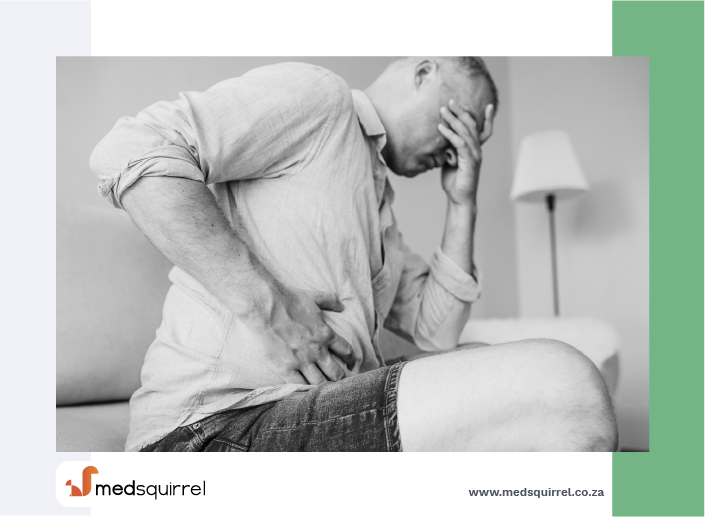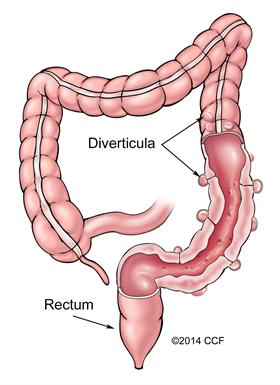Conditions Explained
Disclaimer:
This website is intended to assist with patient education and should not be used as a diagnostic, treatment or prescription service, forum or platform. Always consult your own healthcare practitioner for a more personalised and detailed opinion
Diverticular Disease

We have selected the following expert medical opinion based on its clarity, reliability and accuracy. Credits: Sourced from the Cleveland Clinic, Ohio. Please refer to your own medical practitioner for a final perspective, assessment or evaluation.
Overview
What is diverticular disease?
Diverticular disease consists of two conditions: diverticulosis and diverticulitis.
Diverticulosis is the formation of several tiny pockets, or diverticula, in the lining of the bowel.
Diverticula, which can range from pea-size to much larger, are formed by increased pressure from gas, waste, or liquid on weakened spots of the intestinal walls. Diverticula can form while straining during a bowel movement, as during constipation. They are most common in the lower portion of the large intestine (the sigmoid colon).
Complications affect about 20 percent of people with diverticulosis. One of these complications is rectal bleeding, also called diverticular bleeding. Diverticular bleeding occurs when there is chronic (long-term) injury to the small blood vessels near the diverticula.
The other complication is diverticulitis: Diverticulitis occurs when there is inflammation (swelling) and infection in one or more diverticula. This usually happens when these outpouchings become blocked with waste, allowing bacteria to build up and causing infection.
Diverticulosis is very common in Western populations and occurs in 10 percent of people over age 40 and in 50 percent of people over age 60. The rate of diverticulosis increases with age, and it affects almost everyone over age 80.
Crosscut with colon and diverticula

Symptoms
What are the symptoms of diverticulosis?
Usually diverticulosis does not cause any troublesome symptoms. Some people may feel tenderness over the affected area, or abdominal cramps.
The symptoms of diverticulitis include painful cramps or tenderness in the lower abdomen, and chills or fever.
Complications
What are the complications of diverticulitis?
Serious complications can occur as a result of diverticulitis. Most come from the development of a tear or perforation (hole) of the intestinal wall. If this happens, intestinal waste material can leak out of the intestines and into the surrounding abdominal cavity, which can cause the following problems:
- Peritonitis (a painful infection of the abdominal cavity)
- Abscesses ("walled off" infections in the abdomen)
- Obstruction (blockages of the intestine)
Diagnosis
How is diverticulitis diagnosed?
Because most people with diverticulosis do not have any symptoms, it is usually found when the patient is having tests that are being done for an unrelated reason.
If you are experiencing the symptoms of diverticulitis, it is important to see your doctor for the correct diagnosis. Some symptoms of irritable bowel syndrome and stomach ulcers may be similar to those of diverticular disease.
Your doctor will ask you about your medical history (such as your bowel habits, symptoms, pain, diet, and current medications) and perform a physical exam.
The doctor may order one or more tests to help diagnose your condition. These tests may include X-rays, CT scanning, ultrasound testing, a sigmoidoscopy, colonoscopy, barium enema, and blood tests to look for signs of infection or to see how much bleeding there is.
For people who have rapid, heavy rectal bleeding, the doctor may perform a procedure called angiography to learn where the bleeding is coming from. During this test, doctors inject the patient's arteries with a harmless dye that will allow the doctor to view the source of the bleeding.
Treatment
People who have diverticulosis without symptoms or complications do not need treatment, but it is important to adopt a high-fiber diet.
Laxatives should not be used to treat diverticulosis. The patient should also avoid enemas or use them infrequently.
How is diverticulitis treated?
Diverticulitis sometimes gets better without medical treatment, but in many cases the patient will need antibiotics. Sometimes the infection is so severe that the patient has to be admitted to the hospital for intravenous antibiotics and other supportive care. In rare cases, a surgeon may need to take out the affected part of the bowel.
During the active stage of the infection, many experts recommended eating a low-fiber diet and drinking plenty of water. A month or so after the infection gets better, fiber should be back on the menu.
Emergency treatment, including surgery, may be needed when the antibiotics do not work, and in cases of a large abscess, perforation, peritonitis, or continued rectal bleeding.
If there is an abscess, the doctor may need to drain the fluid by inserting a needle into the infected area. Sometimes surgery is needed to clean the abscess and remove part of the colon.
If the infection spreads into the abdominal cavity (peritonitis), surgery is needed to clean the cavity and remove the damaged part of the colon. Infection can lead to scarring of the colon, and the scar tissue may cause a partial or complete blockage. A complete blockage requires surgery, although a partial blockage does not.
Prevention
How can diverticulosis be prevented?
Good bowel hygiene is most important to prevent diverticular disease or reduce the complications.
This means:
- Having regular bowel movements and avoiding constipation and straining
- Eating appropriate amounts of the right types of fiber
- Drinking plenty of water
- Exercising regularly
The American Dietetic Association recommends 20 to 35 grams of fiber a day. Every person, regardless of whether they have diverticula, should try to consume this much fiber every day. Fiber is the part of plant foods that cannot be digested.
High-fiber foods include:
- Whole grain breads, cereals, and crackers
- Berries and other fruit
- Vegetables, such as broccoli, cabbage, spinach, carrots, asparagus, squash, and beans
- Brown rice
- Bran products
- Cooked dried peas and beans, among other foods
A high-fiber diet helps prevent constipation and provides a number of other health benefits, including lower blood pressure, reduced blood cholesterol, improved blood sugar, and a reduced risk of developing certain intestinal disorders.
Other ways to prevent diverticular disease include drinking eight glasses of water a day, watching for changes in bowel movements (from constipation to diarrhea), and getting enough rest and sleep.
_______________________________________________________________________________________________________________________
Are you a healthcare practitioner who enjoys patient education, interaction and communication?
If so, we invite you to criticise, contribute to or help improve our content. We find that many practicing doctors who regularly communicate with patients develop novel and often highly effective ways to convey complex medical information in a simplified, accurate and compassionate manner.
MedSquirrel is a shared knowledge, collective intelligence digital platform developed to share medical expertise between doctors and patients. We support collaboration, as opposed to competition, between all members of the healthcare profession and are striving towards the provision of peer reviewed, accurate and simplified medical information to patients. Please share your unique communication style, experience and insights with a wider audience of patients, as well as your colleagues, by contributing to our digital platform.
Your contribution will be credited to you and your name, practice and field of interest will be made visible to the world. (Contact us via the orange feed-back button on the right).